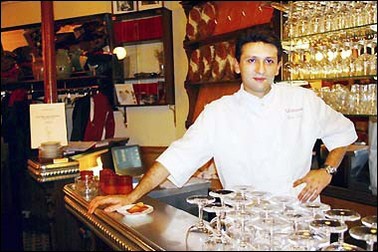Wild game makes gastronomic gains on French menus
January 9, 2005 - Agence France Presse

ARREAU, France (AFP) - For a country that has always sought to be different from the rest when it comes to cuisine, it’s a wonder that this didn’t happen sooner, but across France wild game is making a big comeback.
In the Pyrenean town of Arreau in southwestern France, butcher Henri Delarue has seen a sharp rise in orders for game among his customers.
“I’ve seen the numbers go up in the last year or two,” he said.
“Everyone who lives around here hunts and has a freezer full of the stuff, but in the shop we have a lot of tourists (French and otherwise) who buy it because they like it or are curious and want to try it.”
“The big-name (and very expensive) French restaurants have always had wild game on the menu,” said a critic for the GaultMillau restaurant guide, who asked to remain anonymous.
“Now, however, you’re starting to find it in places you can afford it like neighborhood bistros,” he said, “plus, there are a few restaurants that are becoming wild game destinations.”
La Regalade, where wild game has been on the menu for over 10 years, is one of the critic’s favorite wild game destinations, and its new chef, Bruno Doucet, seems more than happy to carry on the tradition.
“People will now come here and order game as both an appetizer and main course,” he said. “It used to be that the people eating wild game in France were just hunters, but that has changed.”
Indeed, on a Thursday afternoon, La Regalade was packed with a crowd that ranges from big eaters and businesspeople to food tourists. Doucet estimated that during game season, more than one plate in five that they eat is wild game.
“I was really impressed at how much we sold at the beginning of the season—between October 10 and November 10, it was huge,” he said. Game can typically be found on French restaurant tables between October and February.
A hunter himself, Doucet thinks that part of game’s popularity is due to the lifestyle surrounding it. “Hunting is a way to dress, a way to walk—I don’t even end up shooting much,” he admitted. “It’s more of an excuse to travel and see things.”
Across town, The Taxi Jaune (The Yellow Taxi) is one of the more affordable restaurants just beginning to put game on their menu.
“Our parents really didn’t teach us what wild game is,” said Otis Lebert, Taxi Jaune’s owner and head chef.
“For years, we said to ourselves that it wouldn’t work, but I started putting it on the menu this year and it has been really well received,” he added, describing a sort of generation gap wild game fell into.
On the menu board above his head, Lebert is serving up doe with a cocoa sauce as part of a longer list of game he’s had on the menu since the game season began in October.
Lebert seems to understand why game went out of fashion.
“If you have a bad experience, you’ll keep that in your head for years,” he said.
“If you eat a tough cote de boeuf one day, you’ll still eat a different cut of beef the next. Wild game done wrong is horrible. It’s like eating 15 day old used chewing gum!”
Game also seems to go against the comparatively dainty grain of the nouvelle cuisine movement. “If you cut open a hare, how many people are going to stick around to eat it?” he asked.
Despite all of this, Lebert’s own taste for game might explain why it’s finally on Taxi Jaune’s menu, “We had a haunch of venison roasted in the oven for eight or ten hours at a friend’s house in Burgundy last year. It melted in your mouth, c’etait magnifique!”
The French rediscovery of game is also part of the larger trend of rediscovering products with terroir, an elusive term that combines heritage and soil.
“It’s a return toward seasonal eating, ancestral habits, terroir and tradition,” said Jean-Jacques Dost, managing director at the Cave de Rasteau, a cooperative winemaker in Provence.
Like a Chateauneuf du Pape or a Cornas, the Cote du Rhone wines coming out of Rasteau are well-known for their ability to stand up to game.
Dost said that in the tiny village of Rasteau, population 600, “eighty percent of the population are winemakers and ninety percent are hunters ... or vice versa. They’re not winemakers or hunters, they’re both.”
“People finish harvesting their grapes on one day and start hunting the next.”
Asked if he’ll be sad to see the wild game season end and Dost, himself an occasional hunter, is surprisingly cheery. “Naw,” he said, “we’ll still have truffles!”